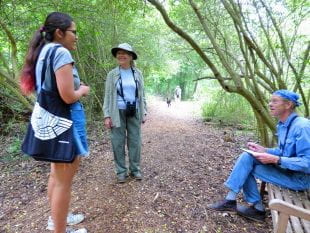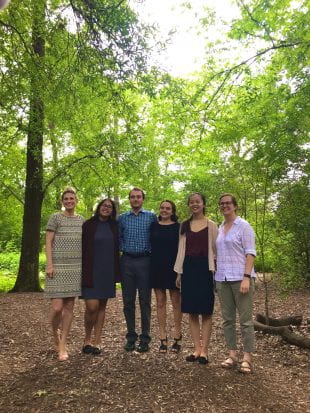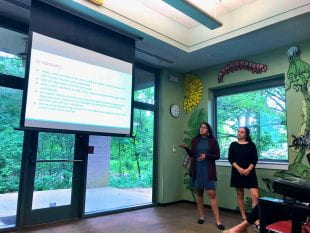CCL’s Houston Action Research Teams develop creative responses to civic challenges
Not everyone visiting the Houston Arboretum on a recent Saturday morning wanted to have their birdwatching or nature-walking interrupted by a survey-taker with a clipboard. Some people gave a quick “no” when approached, but others eagerly tackled the survey’s four pages.

Rice senior Ramee Saleh, left, polled visitors at the Houston Arboretum and Nature Center on a recent Saturday morning. (Photos by Katharine Shilcutt)
This is how Rice senior Ramee Saleh and her fellow students on this Houston Action Research Team (HART) spent their last semester, trekking along the trails and gathering survey data on visitor experiences for the Houston Arboretum and Nature Center.
“I know this loop pretty well by now,” Saleh said as she finished up with one visitor — a woman enjoying a lakeside view from a bench under a shade tree — and headed out in search of the next.
Each semester, through Rice’s Center for Civic Leadership (CCL), HART partners with community organizations — this year’s cohort also includes collaborations with the Memorial Park Conservancy and the Houston Fire Department — to provide paid opportunities for Rice undergrads. They help develop creative responses to these organizations’ various challenges, such as, “How effective are the HFD’s community safety programs?”
At the Arboretum, Saleh and her colleagues approached everyone they encountered with the same query: “Hi, I’m a Rice student and I’m working with the Arboretum to learn more about who comes and what they do here. I was wondering if you wouldn’t mind filling out a five-minute survey.”
One man walking his dog simply shook his head. He and his four-legged friend walked on down a sunny path through an open field full of flowers, the puppy pulling at the leash.
“Dog-walkers are more likely to say no,” Saleh said. “Probably because they have a dog.”

Rice HART members Ramee Saleh, Dawson Klein, Sarah Torresen and Tian-Tian He (left to right) worked with Houston Arboretum development director Keely Everett (far left) and marketing and development manager Christine Mansfield (far right) on the project.
Her HART cohort prepared for this, with various statistical methods in place to provide caveats for the data they’re capturing, “like limitations of findings,” Saleh said. “We can say, ‘dog-walkers are underrepresented and here’s the reason.’”
Most of the visitors the Rice students approached in the Arboretum were more than happy to share their thoughts on everything from the new paid-parking lots to the recently redeveloped trails.
On that Saturday morning, the place was packed. Saleh, a Sid Richardson College double-major in economics and policy studies, had her pick of people to poll. But even on a gloomy Wednesday afternoon, Brown College senior Dawson Klein, who’s graduating with a degree in anthropology, found plenty of subjects: a mother and her two small children at the playground; a small-business owner who comes here to walk and think; a couple who had chosen a drizzly Wednesday afternoon at the Arboretum as their first date.
The questions on the survey, written by HART members Klein, Saleh, Baker College junior Tian-Tian He and Sid Richardson College senior Sarah Torresen, were designed to gather everything from demographic data to information on which trails and programs were most popular. Two open-ended questions asked visitors what they’d change or add to the Arboretum.
“That was the first part of our project: finding out what questions we needed, what questions the Arboretum had that we were trying to answer, who we needed to survey, where we needed to survey, all the details,” Klein said. “This second-to-last part is surveying people and then, after this Sunday, we’re going to crunch the data and give the final report to the Arboretum.”
Even before they finished their surveying, the students had seen some themes emerge, especially in the answers to those open-ended questions.
“There are some pretty common ones like they want more places to put dog poop,” Klein said. “But some people say, ‘You shouldn’t do anything to the Arboretum; it’s fine as it is.’”
In the end, the team gathered 183 surveys during a one-month period with the help of a few Arboretum volunteers, producing over 500 pages of data. The team didn’t bring the entire printed volume of results to its final presentation for the Arboretum staff, members joked; lugging along that much paper somehow seemed antithetical to the Arboretum’s mission.
Instead, an informative half-hour presentation was given to a room full of naturalists and other Arboretum staff. The team’s detailed findings elicited interested chatter. Questions followed for each of the HART members and their advisers — graduate student Matt Lamb and faculty advisers Randal Hall and Richard Johnson — and after an hour, they were still discussing the data.
The visitors skewed younger than both the students and the Arboretum expected. Dog-walkers were one of the most likely groups to come a number of times a week, while first-time visitors made up nearly half of those surveyed. Out-of-towners came from a number of states across the U.S., but most of them had been brought by a Houstonian (and some by Google searches for something beautiful to see in Houston). Parents with toddlers wanted more programs geared towards their children; families wanted more free events.
“We came in knowing about the Houston Arboretum’s three-year master plan funded by the $25 million capital campaign and all the major transformation it’s going to make at the Arboretum, including the reevaluation of programming, new navigational signage and new educational materials like the field stations that are popping up,” Saleh said during their presentation.
The data gathered, she said, would hopefully help inform these changes. Christine Mansfield, the Arboretum’s marketing and development manager who worked closely with the HART students throughout the semester, agreed.
“The study results give us a lot of exciting food for thought as we move forward with our master plan and expand our programming and visitor amenities,” she said.
Many of the students’ main points confirmed anecdotal staff observations, Mansfield said, “and it was nice to see that many of the projects we are currently working on will address the majority of the students’ suggestions for improvements.”
Between the Rice community members who volunteer at the Arboretum and the Arboretum’s longstanding relationship with the CCL, partnering with the HART students on a project like this was a natural, Mansfield said.
“We work with Rice students pretty regularly on a variety of conservation and education projects and they’re always wonderful to work with,” she said.


